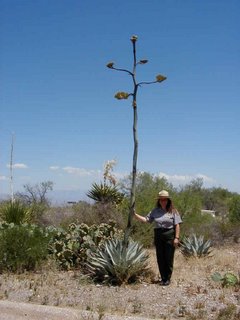 I picked this bit up from the Olde Towne East egroup. Tom House received this and sent it to me.
I picked this bit up from the Olde Towne East egroup. Tom House received this and sent it to me.COLUMBUS, Ohio - A once-in-a-lifetime event is about to happen at Franklin Park Conservatory. The Century Plant, also known as Agave americana, is predicted to bloom this month or next in the Desert biome of the Franklin Park Conservatory. The name, Century Plant, derives from the fact that it is known for blooming only once in its lifetime, with a life span of up to 60 years.
When the Century Plant blooms, the giant asparagus-like blooming stalk is so large and grows so fast-up to 8 to 12 inches a week-that it saps all the resources of the plant, which then dies shortly after, leaving a tall wooden seed stalk.
The Century Plant doesn't really take a century to bloom, but it does take approximately 15 years in warm regions and as much as 60 years in colder climates. What exactly triggers the plant to start growing its flower stalk is still a myth to horticulturists.
The last time a Century Plant bloomed at Franklin Park Conservatory was in 1986. The flower stalk grew so tall that Conservatory staff had to remove the glass windows in the Showhouse roof so the Century Plant could continue its upward growth. A flower stalk can measure up to 40 feet high and bears incredibly fragrant large yellow-green flowers, which can be up to four feet wide.
The plant stems from a spreading basal rosette, which can expand up to 12 feet wide. The rosette has large gray-green leaves that can get up to six feet long, each with a spiny margin and a heavy spike at the tip.
The Century Plant is an agave originally from Mexico's arid highlands, but can be cultivated worldwide. It was an important plant to indigenous people, used for medicines, fiber, needles, and food.
For more info, visit: www.fpconservatory.org.
Franklin Park Conservatory
1777 East Broad Street
Columbus, Ohio 43203
614.645.TREE or 800.214.PARK
Note: I found some good pictures of the plant, including the one above here on the official Big Bend National Park website.






No comments:
Post a Comment